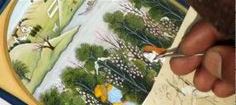Indian painting has always been the glory of ‘the country of diversity’ and with the introduction of the Pahari painting style during the 17th to 19th centuries, the Indian art & craft has reached a stage untouched.
India witnessed the development of painting almost 2000 years ago and since then, Indian painting has only evolved. This is also true for Pahari miniature painting, a form of Indian art that’s closely linked with Rajput paintings. However, it will be a disservice to the Pahari style of painting, if we don’t talk about miniature painting a bit. It’s believed that miniature painting came into existence in India during the 9th to 10th centuries. However, its evolution only began when India came under the rule of the Mughals.

Story Behind Pahari Paintings
Being an art form growing under the shadow of Mughal Emperors, the Persian influence on the pictures was pretty prominent. But it didn’t take long for the artists to accentuate their very own Indian influence. As time passed by, the patrons of miniature paintings spread all over India, mostly Himachal Pradesh where Himachal Pradesh painting earned its glory. These miniature marvels, hailing from the picturesque landscapes of Himachal Pradesh, reflect the rich cultural heritage and artistic finesse of the region. Embellished with intricate details, stories of Indian epics, and vibrant hues, Himachal day paintings narrate timeless tales that modern-day Indians/artists still cherish.

Process of Pahari Paintings
The creation of Pahari paintings is all about precision and patience. All the artists follow the same techniques to create the hill paintings in their truest form. The simple and indigenous Pahari art begins with the preparation of the canvas - handmade paper sheets are bound together for the necessary paper thickness. Artisans then outline the composition using light pencil strokes and a transparent coating is applied over it. Now it’s time to bring the sketches alive using vibrant colours.

Tools Used for Pahari Art
Central to the paintings of Himachal Pradesh are the traditional tools and materials that breathe life into each creation. The tools used in this art form range from delicate brushes made from squirrel, horse or camel hair or peacock wings to natural pigments sourced from minerals, trees, flowers and fruits, it’s one of the most eco-friendly paintings.
The painters sometimes also use gold dust to make the pictures shine extra. And the use of poison is pretty common in Himachal culture painting. The poison is made from soot and plants or tree parts where poison remains stored. The poison protects the paintings from decaying.

10 Types of Pahari Paintings
The Pahari painting tradition encompasses a diverse array of styles and themes, each reflecting the unique cultural milieu and artistic sensibilities of the region. Let’s explore them:
Kangra Paintings
Pahari paintings that mostly feature ethereal landscapes, the sublime beauty of nature and women, and depict the divine love of Radha-Krishna, fall under this category/type of Pahari art. It was introduced in the 1800s and adorns the homes of Indians to this day.

Basohli Paintings
The splendid Devi series of Pahari painting styles originated in the Basohli town of Himachal. Vibrant colours, glossy enamel and bold compositions are the primary features of this Basohli painting style. This school of hill paintings depicts mythological narratives and celestial beings through intricate detailing and dynamic brushwork.

Jammu Paintings
Being very similar to the Kangra style of Pahari painting, many often confuse Jammu paintings with the previous one.

Chamba Paintings
Heavily influenced by Mughal paintings, this painting style also reflects influences from Gujrat and Deccan styles of paintings.

Garhwal Paintings
Originating in Srinagar by the artists who settled there, this painting style shifted from being Mughal-influenced to being influenced by Kangra tradition.

Bilaspur Paintings
This painting style was mostly influenced by stories of Ragamala, Ramayana and Bhagavad Purana. It originated in Bilaspur of Himachal Pradesh in the 17th century.

Jasrota Paintings
Pahari painting style that revolves around court scenes, allegorical scenes or scenes involving kings fall under this category.

Mandi Paintings
Evolved under the rule of King Sidh Sen in Mandi, this painting style covers kings with massive heads, feet and hands. Apart from such features, natural elements were also pretty common in them.

Nurpur Paintings
Pahari miniature paintings that mostly use muted colours are known as Nurpur paintings. However, dark colours were introduced in this Pahari style of painting later on.

Mankot Paintings
Another Pahari art that resembles Basohli paintings is Mankot painting with a focus on subdued hues, naturalism, and portraits.

Himachal Pahari's Art is Inspired by the following Themes
Being an art form that flourished under the kings, raja, maharaja, and in the court settings, the influence of the kingdom in Pahari painting is prominent. However, the influence also extends to popular literary compositions of the time, Radha-Krishna, Hindu myths, pastoral idylls, hill life, people living in hills, folk tales, celestial deities, spiritual quests, and more.
There’s no denying the fact that Pahari paintings are some of the prettiest proof of the ingenuity and creativity of the human spirit and artists. Rooted in tradition yet imbued with innovation, these miniature marvels continue to enchant and inspire generations with their grace and beauty.
As custodians of this rich cultural legacy, it is our collective responsibility to cherish and preserve the heritage of Pahari art for posterity. Let us celebrate the exquisite craftsmanship and profound storytelling that define this long-lasting art of India, ensuring that its graceful narratives endure for generations to come.
Why not welcome the enchanting world of Pahari paintings in your home? It’s the perfect opportunity to immerse yourself in the classic beauty of Himachal culture painting. iTokri has a large collection of handmade products inspired by the Pahari art. You can now make the Indian craft a tool of home decor. Intriguing, no? Join us on a journey of discovery and rediscover the magic of Pahari miniatures today.
 Verified Purchase
Verified Purchase
























Leave a comment (all fields required)